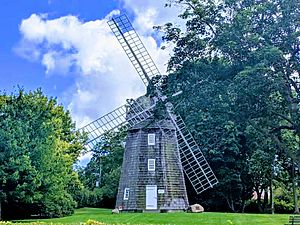Beebe Windmill facts for kids
Quick facts for kids Beebe Windmill |
||||||||||||||||
|---|---|---|---|---|---|---|---|---|---|---|---|---|---|---|---|---|

Beebe windmill
|
||||||||||||||||
| Origin | ||||||||||||||||
| Mill name | Beebe mill | |||||||||||||||
| Mill location | Bridgehampton, New York | |||||||||||||||
| Coordinates | 40°56′03″N 72°18′02″W / 40.9343°N 72.3006°W | |||||||||||||||
| Year built | 1820 | |||||||||||||||
| Information | ||||||||||||||||
| Purpose | Corn mill | |||||||||||||||
| Type | Smock mill | |||||||||||||||
| Storeys | Four-story smock | |||||||||||||||
| Base storeys | A few courses of brick | |||||||||||||||
| Smock sides | Eight-sided smock | |||||||||||||||
| No. of sails | Four sails | |||||||||||||||
| Type of sails | Common sails | |||||||||||||||
| Windshaft | Wood | |||||||||||||||
| Winding | Fantail | |||||||||||||||
| Fantail blades | Eight blades | |||||||||||||||
| Auxiliary power | Steam engine | |||||||||||||||
| No. of pairs of millstones | Two pairs | |||||||||||||||
| Other information | Named after Lester Beebe, for whom it was built. | |||||||||||||||
|
||||||||||||||||
The Beebe Windmill is a very old and important windmill located in Bridgehampton, New York. It stands at the corner of Ocean Road and Hildreth Avenue. This windmill has a long history and unique features that make it special.
Contents
History of the Beebe Windmill
How the Mill Was Built and Moved
The Beebe Windmill was first built in 1820. It was made in Sag Harbor for a person named Lester Beebe. After Lester Beebe passed away, a woman named Rose Gelston bought the windmill. She had it moved to Bridgehampton. The mill then worked there for more than 50 years, grinding corn.
Changes Over Time
In 1882, James Sanford bought the windmill. He moved it to a new spot south of the railroad tracks. Later, a steam engine was added to the mill. This was a clever idea! It meant the mill could still work and grind corn even when there was no wind.
In 1888, a skilled builder named Nathaniel Dominy from Long Island fixed the mill. The next year, in 1889, the mill was moved again. This time, it went to a place north of the railroad. The Bridgehampton Milling Company used the windmill here until 1915.
Its Final Home
In 1915, John E. Berwind bought the windmill. He moved it to his summer home, which was called Minden. This is where the Beebe Windmill stands today.
Why This Windmill Is Special
The Beebe Windmill is very unique. In 1977, experts described it as one of the first windmills on Long Island to have special parts. These parts included a "fly" (also known as a fantail), "regulators," and gears made of cast iron. A fantail is a small windmill at the back that automatically turns the main sails into the wind. Regulators help control how fast the millstones turn.
The Beebe Windmill is the only one left with its original versions of these parts. It also has a special "decorative" design. Because of these features, it is the only surviving Long Island windmill that is similar to English windmills from the same time period. In 1978, the Beebe Windmill was added to the National Register of Historic Places. This means it is recognized as an important historical site.
How the Beebe Windmill Works
The Beebe Windmill is a four-story smock mill. This means it has a tall, tower-like body that gets narrower at the top. It has a special cap that looks like an "ogee" shape. A fantail on the back helps the cap turn to face the wind.
Inside the Mill
The windmill has four large Common sails (the big blades you see). These sails are attached to a strong wooden windshaft. The windshaft is a large axle that spins when the wind pushes the sails.
Connected to the windshaft is a wooden brake wheel. This wheel helps control the speed of the mill. The brake wheel turns a cast iron wallower. The wallower is a smaller gear at the top of a long, upright pole called the upright shaft.
At the bottom of the upright shaft, there's another cast iron gear called the great spur wheel. This big gear turns two pairs of overdrift millstones. These millstones are heavy, round stones that grind corn into flour. The term "overdrift" means the grain is fed into the center of the top stone.
Images for kids



